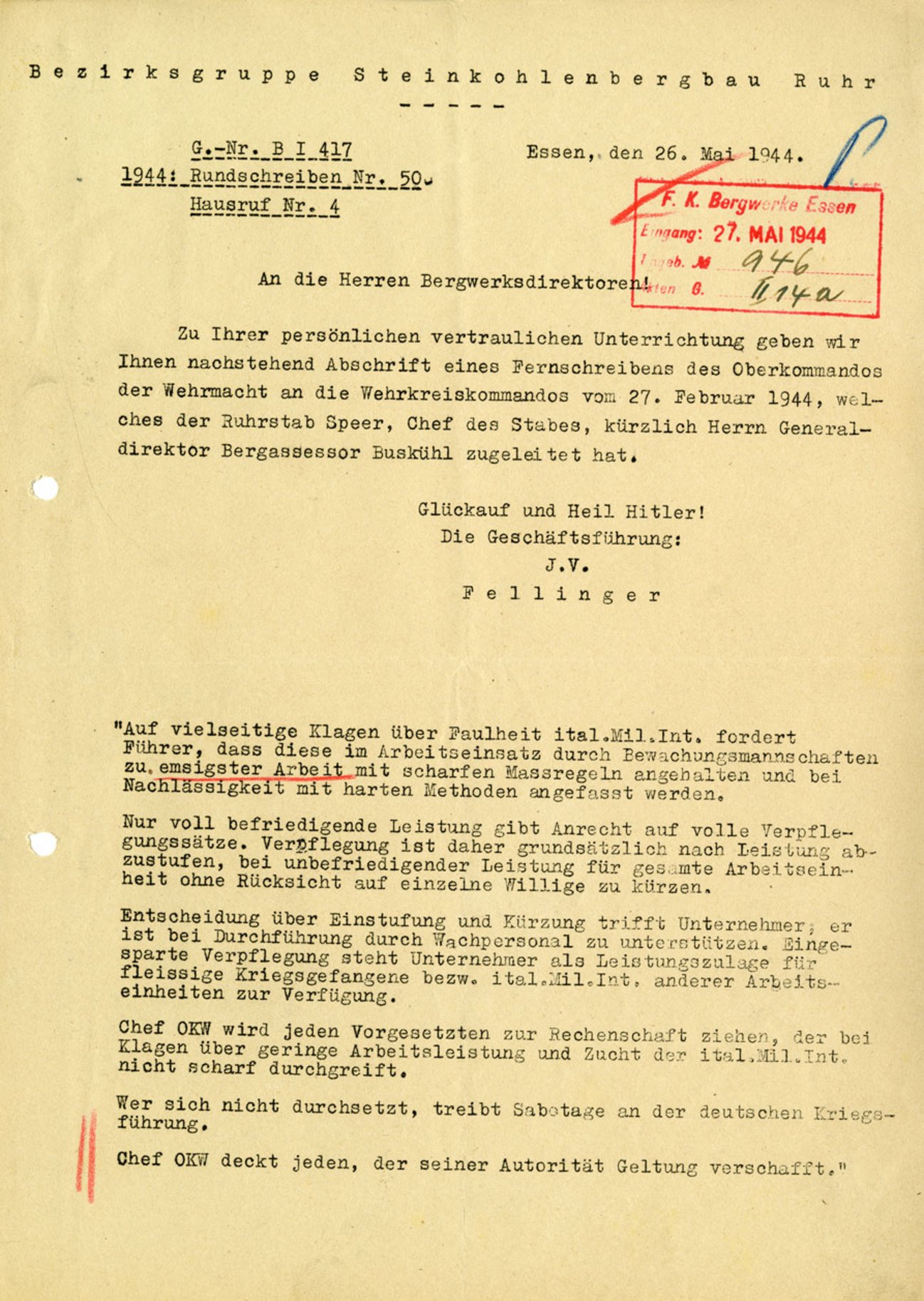Orders and letters: Circular from the Steinkohlenbergbau Ruhr District Group on the Introduction of “Performance Rations”, Essen, 26 May 1944
Who wrote the letter and in what context was it written?
The Prisoners of War Office of the High Command of the German Armed Forced (OKW) issued Adolf Hitler’s order on the introduction of “performance rations” for Italian military internees (IMIs) by telegraph at the end of February 1944. Companies were instructed to grade workers’ food rations according to their work performance and reduce rations for whole work units if they were not satisfied with their performance. Some companies had already introduced this means of punishment on their own initiative.
The telegraph from the OKW also reached the management of the Ruhr Coal Mining District Group. On 26 May 1944 they sent a circular to the mine directors informing them of the introduction of “performance rations”.
What can we see?
In the top section of the circular we can see the sender, number, place and date. A red stamp confirms that the copy reproduced was received by Friedrich Krupp (F. K.) Bergwerken Essen on 27 May 1944. A brief message explains the content of the circular and draws attention to its secret nature. Then there is a reproduction of the original telegraph from the OKW. The author and date of the red and blue marks can no longer be determined with any certainty. The red initials are probably those of the mine director, Gerhard Rauschenbach, the director of Bergwerke Essen, while the blue initials are probably those of his deputy works director, Heinrich Pilger. This means that both of them were aware of the letter.
What does the circular reveal about Nazi forced labour and what should be taken into account when dealing with letters in educational work?
Official letters give us an insight into who was involved in organising forced labour in the German Reich, who profited from it and how the various historical actors worked with each other. Content and language can also give an indication of what motivated actors in their actions.
Hitler’s order concerning the introduction of “performance rations” and the telegraph from the OKW are indications of the special situation of the Italian military internees. After Italy’s ceasefire with the Allies, the Nazi leadership, the German military and sections of the German population regarded their former ally as traitors, and so the treatment they were subjected to was all the worse.
The circular exemplifies how actors at various levels determined the living and working conditions of forced labourers by their decisions and actions. Hitler’s order to introduce “performance rations” grew largely from the desire for revenge for Italy’s capitulation. In its telegraph, the OKW also refers to complaints about the work performance of the Italian military internees, which was in line with widespread prejudices about Italian laziness. These complaints came from local companies, which were now informed of Hitler’s order via several levels of bureaucracy. They are threatened with consequences if they fail to implement the measure. At the same time, the OKW concedes in its original telegraph that the assessment of work performance is up to the companies themselves, so that they have leeway in their decision-making.
What do we not see?
Many Italian military internees were already malnourished, ill and poorly equipped when they arrived in German captivity. Their rations were also less than those of civilian forced labourers were. These weakened people were not capable of doing the work that was demanded of them. But they were frequently accused of laziness. The “performance rations” were intended to make the Italian military internees to work harder. Instead, however, they had the opposite effect. People who were already weakened were made even weaker by food deprivation, so that their work performance was reduced even further.
Literature
Hammermann, Gabriele: Zwangsarbeit für den „Verbündeten“. Die Arbeits- und Lebensbedingungen der italienischen Militärinternierten in Deutschland 1943-1945. Tübingen: Max Niemeyer Verlag, 2002, in particular Chapter „Die ‚Leistungsernährung‘: Vorläufer in der Industrie und ‚Führererlaß‘“, pp. 234-244.
Hammermann, Gabriele: „Die italienischen Militärinternierten zwischen 1943 und 1945“, in Dokumentationszentrum NS-Zwangsarbeit Berlin (ed.): Zwischen allen Stühlen. Die Geschichte der italienischen Militärinternierten 1943-1945. Berlin: Dokumentationszentrum NS-Zwangsarbeit der Stiftung Topographie des Terrors, 2017, pp. 28-41.
Hammermann, Gabriele (ed.): Zeugnisse der Gefangenschaft. Aus Tagebüchern und Erinnerungen italienischer Militärinternierter in Deutschland 1943-1945. Berlin, Munich & Boston: De Gruyter Oldenbourg, 2014.
Jah, Akim and Gryglewski, Marcus: „Wie lese ich ein Dokument? Anmerkungen zur archivpädagogischen Arbeit mit historischen Dokumenten“, in id.: „Ihre Grabstätten befinden sich nicht im hiesigen Bezirk.“ Quellen zur Deportation der Jüdinnen und Juden im Nationalsozialismus. Materialien für den Unterricht und die außerschulische Bildung. Leipzig: Hentrich & Hentrich, 2018, pp. 15-17.

